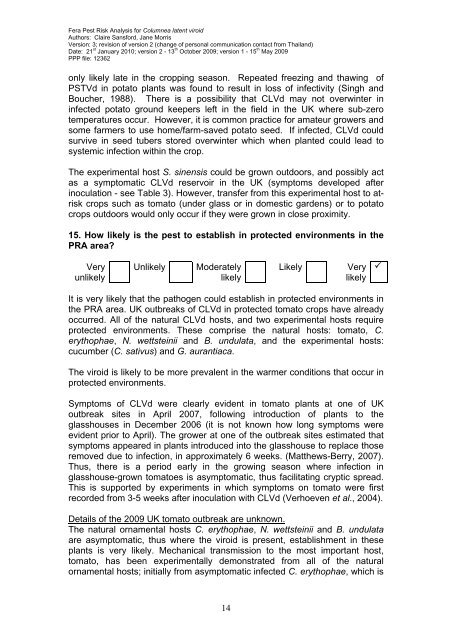Columnea latent viroid - The Food and Environment Research ...
Columnea latent viroid - The Food and Environment Research ...
Columnea latent viroid - The Food and Environment Research ...
You also want an ePaper? Increase the reach of your titles
YUMPU automatically turns print PDFs into web optimized ePapers that Google loves.
Fera Pest Risk Analysis for <strong>Columnea</strong> <strong>latent</strong> <strong>viroid</strong><br />
Authors: Claire Sansford, Jane Morris<br />
Version: 3; revision of version 2 (change of personal communication contact from Thail<strong>and</strong>)<br />
Date: 21 st January 2010; version 2 - 13 th October 2009; version 1 - 15 th May 2009<br />
PPP file: 12362<br />
only likely late in the cropping season. Repeated freezing <strong>and</strong> thawing of<br />
PSTVd in potato plants was found to result in loss of infectivity (Singh <strong>and</strong><br />
Boucher, 1988). <strong>The</strong>re is a possibility that CLVd may not overwinter in<br />
infected potato ground keepers left in the field in the UK where sub-zero<br />
temperatures occur. However, it is common practice for amateur growers <strong>and</strong><br />
some farmers to use home/farm-saved potato seed. If infected, CLVd could<br />
survive in seed tubers stored overwinter which when planted could lead to<br />
systemic infection within the crop.<br />
<strong>The</strong> experimental host S. sinensis could be grown outdoors, <strong>and</strong> possibly act<br />
as a symptomatic CLVd reservoir in the UK (symptoms developed after<br />
inoculation - see Table 3). However, transfer from this experimental host to atrisk<br />
crops such as tomato (under glass or in domestic gardens) or to potato<br />
crops outdoors would only occur if they were grown in close proximity.<br />
15. How likely is the pest to establish in protected environments in the<br />
PRA area?<br />
Very<br />
unlikely<br />
Unlikely<br />
Moderately<br />
likely<br />
Likely Very<br />
likely<br />
<br />
It is very likely that the pathogen could establish in protected environments in<br />
the PRA area. UK outbreaks of CLVd in protected tomato crops have already<br />
occurred. All of the natural CLVd hosts, <strong>and</strong> two experimental hosts require<br />
protected environments. <strong>The</strong>se comprise the natural hosts: tomato, C.<br />
erythophae, N. wettsteinii <strong>and</strong> B. undulata, <strong>and</strong> the experimental hosts:<br />
cucumber (C. sativus) <strong>and</strong> G. aurantiaca.<br />
<strong>The</strong> <strong>viroid</strong> is likely to be more prevalent in the warmer conditions that occur in<br />
protected environments.<br />
Symptoms of CLVd were clearly evident in tomato plants at one of UK<br />
outbreak sites in April 2007, following introduction of plants to the<br />
glasshouses in December 2006 (it is not known how long symptoms were<br />
evident prior to April). <strong>The</strong> grower at one of the outbreak sites estimated that<br />
symptoms appeared in plants introduced into the glasshouse to replace those<br />
removed due to infection, in approximately 6 weeks. (Matthews-Berry, 2007).<br />
Thus, there is a period early in the growing season where infection in<br />
glasshouse-grown tomatoes is asymptomatic, thus facilitating cryptic spread.<br />
This is supported by experiments in which symptoms on tomato were first<br />
recorded from 3-5 weeks after inoculation with CLVd (Verhoeven et al., 2004).<br />
Details of the 2009 UK tomato outbreak are unknown.<br />
<strong>The</strong> natural ornamental hosts C. erythophae, N. wettsteinii <strong>and</strong> B. undulata<br />
are asymptomatic, thus where the <strong>viroid</strong> is present, establishment in these<br />
plants is very likely. Mechanical transmission to the most important host,<br />
tomato, has been experimentally demonstrated from all of the natural<br />
ornamental hosts; initially from asymptomatic infected C. erythophae, which is<br />
14
















